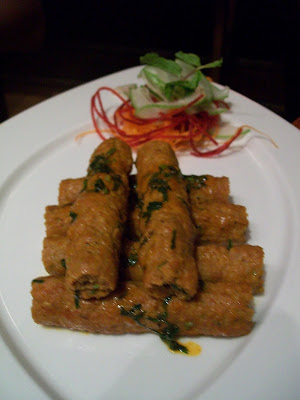
Wazwan is one of the most famous and still untouched cuisines of India. Very few restaurants foray into this rich food culture and those who do, do not go beyond Roganjosh or Kashmiri Pulao. Well, there's a lot more to this cuisine which is influenced by Kashmiri Pandits, Muslims from Samarkand and surprisingly Buddhist Monks who migrated to Kashmir from Laddakh. My interest in Wazwan was generated when I read Salman Rushdie's Shalimar The Clown several years ago and that's what took me to Kong Poush, a now shuttered Kashmiri restaurant in Oshiwara which was my real introduction to Wazwan. Given the extreme unavailability of Wazwan food in Mumbai it was tough to say no when an invitation to taste the Kashmiri food came my way.
Masala Bay at Taj Lands End in Bandra is celebrating the elaborate cuisine till the 31st of March and has flown down Chef Sewa Singh from Vivanta by Taj in Srinagar to prepare the delicacies. Apart from the bloggers and the people from media the Executive Chef of Taj Lands End, Chef Anirudha Roy also joined us for dinner. It was an extremely fruitful evening with good food, good wine and conversations about the history of Wazwan, the food culture in Kashmir and books. The normally media shy Chef spoke to us at length on various topics.
As far as the food is concerned I am in love with the subtle flavours used in Wazwan dishes. The spices never overpower the principal ingredient. Wazwan, which is mainly a celebratory cuisine comprises of 36 dishes. Well actually the original cuisine had 105 dishes but most of them are lost in history. The menu at Masala Bay has included at-least 15 dishes out of the 36. They also serve a Peach mocktail garnished with kesar which gels well with the food.
Although soup or shorba - very mildly spiced lamb broth, is not really a part of Wazwan it has been included in the menu and was a pretty good start to the meal.
The Kashmiri sheek kebabs were succulent, moist and full of spices unlike the dry sheek available at Mumbai's most famous joints. Try them with the Apricot chutney served on the side.
Nadir or lotus stem is probably the most important part of Kashmiri cuisine and after eating the Nadir kebabs you won't be wondering why. The soft and crunchy kebabs are made with a mix of lotus stem and dryfruits.
While the vegetarian options are limited the Paneer ki tikki is something that'll keep you happy. Made with fresh cottage cheese, anardana and dryfruits the tikki is a fabulous blend of sweet and spicy flavours.
The main course has dishes like Rista which is served at the beginning of the meal. Rista is made with pounded meatballs (there's a long process to prepare this meat where it is pounded till the red meat turns white and then it's made into balls) cooked in a Kashmiri gravy made with moval extract, asofoetida, fennel and other spices. Gushtaba which is served at the end of the meal is the same meatballs cooked in a tangy yogurt gravy. We were blown over by both the dishes. The Mutton roganjosh was cooked with no onion or garlic in just ginger, asofoetida and fennel gravy and had meat falling off the bone. This with Kashmiri zafarani naan was a combination made in heaven, and with the food coming straight from the heaven on Earth I wouldn't question that.
The rich Rajma made with small kidney beans and the Morel pulao was again something that had subtle flavours. Chef Anirudha told us that the technique to make the morel pulao is again very long and complimented which is one reason we don't see it on a restaurant's menu.
Another special addition to our meal was the small grained Kashmiri rice which the Chef had brought from the land itself. Now here's an interesting fact that rice is actually the staple diet of a Kashmiri. A lot of their agriculture is based on rice. Bread on the other hand is mostly eaten for breakfast with Nun chai or salted tea. Rice or baatha is so important that during a Kashmiri wedding there's a special function which involves cleaning of rice for the wedding. Only the closest female members of the family are invited to clean the rice. You can read more about it here. We were served this rice with Tilapia, Kashmiri fish cooked in red chilli gravy, another pair made in heaven.
The dessert wasn't the usual Phirni, surprisingly, but was Suji ka halwa instead. The mildly sweetened semolina halwa had bigger grains instead of the regular small and fine ones.
The meal ended with a flavourful Kahwa, a Kashmiri tea which doesn't have any tea and is made of cinnamon, cardamom, clove and fennel.
It's a pity that we are not aware of a cuisine which is so vast and is a culture in itself. I wouldn't be exaggerating if i say that Wazwan is not just food, it's a way of life.
The Wazwan Food Festival is on till the 30th of March.

Ingredients:
Lamb cubes (with bone) 1 kg
Desi ghee 110 gms
Turmeric powder 10 gms
Kashmiri chilli powder 25 gms
Dried Kashmiri chillies 30 gms
Lamb stock 1 ltr
Dry ginger powder 50 gms
Fennel powder 25 gms
Green cardamom 5 nos.
Cinnamon stick 4-5 nos.
Dry mint powder 10 gms
Lamb fat 30 gms
Salt to taste
Method:
· Blanch the lamb and wash to clean off all impurities.
· Boil the whole chillies until soft, wash and make a fine paste with water.
· Take ghee and lamb fat in a vessel, add cardamom and cinnamon, allow it to crackle.
· Add salt, turmeric, red chilli powder, and red chilli paste and lamb stock.
· Now add lamb, and cook until tender.
· Remove lamb, strain the gravy and cook further till desired consistency.
· Check for seasoning, finish with ginger powder, fennel powder and mint powder & serve hot.
























